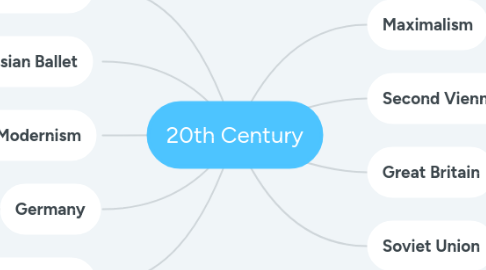
1. Maximalism
1.1. Mahler
1.1.1. Nine symphonies
1.1.2. Expanded length, volume, texture, key relationships
1.2. Strauss
1.2.1. Salome
1.2.1.1. decadence in opera: pushing the limits of morality
1.2.2. Elektra
2. Second Viennese School
2.1. Schoenberg
2.1.1. Emancipation of dissonance
2.1.1.1. atonlity
2.1.2. 12-tone
2.1.3. Sprechstimme
2.1.3.1. Pierott Lunaire
2.2. Berg
2.2.1. Large-form works
2.2.1.1. Wozzeck
2.2.1.2. Lulu
2.3. Webern
2.3.1. Orchestration
2.3.2. Inspiration for total serialism
2.3.3. Extremely short works
2.3.4. Klangfarbenmelodie
2.4. Society for Private Musical Performances
2.4.1. No clapping, reviews, demonstrations
2.4.2. Works were repeated often
2.4.3. No critics
2.4.4. Works were well rehearsed
3. Modernism in France
3.1. Erik Satie
3.1.1. Influenced Debussy and the Les Six
3.2. Debussy
3.2.1. Impressionism
3.2.2. Symbolism
3.2.2.1. Pelleas et Melisande
3.3. Ravel
3.4. Lili Boulanger
3.5. Nadia Boulanger
3.5.1. Taught many 20th c. composers
3.6. Messiaen
3.6.1. Modes of Limited Transposition
3.6.2. Quartet for the end of time
3.6.2.1. Prisoner of war camp
3.6.2.2. Clarinet, piano, cello, violin
3.7. Les Six
3.7.1. Surrealism
4. Russian Ballet
4.1. Tchaikovsky
4.1.1. Swan Lake
4.1.2. Sleeping Beauty
4.1.3. The Nutcracker
4.2. Ballet russes
4.2.1. Sergey Diaghilev
4.2.2. Stravinsky
4.2.2.1. Rite of Spring
4.2.2.2. Petrushka
4.2.2.3. Firebird
4.2.3. Erik Satie
5. American Modernism
5.1. Charles Ives
5.1.1. Transcendentalism Movement
5.1.2. Atonality
5.1.3. American Folk Music
5.1.4. Microtones
5.2. Henry Cowell
5.2.1. Tone clusters
5.2.2. Performing on the strings of the piano
5.3. Ruth Crawford
5.3.1. String Quartet 1931
5.3.1.1. "Total serialism" / Integral serialism
5.4. Harry Partch
5.4.1. 43 interval scale
5.4.2. microtones
5.4.3. unusual instruments
5.5. Aaron Copland
5.5.1. Folk Music / Populist Music
5.5.1.1. Appalachian Spring
5.5.2. Patriotic Music
5.5.2.1. Lincoln Portrait
5.5.2.2. Fanfare for the Common Man
5.5.3. Serialism followed McCarthy trials
5.5.4. Wide intervals, open textures
5.6. Barber
5.6.1. Adagio for Strings
5.7. John Cage
5.7.1. Prepared piano
5.7.2. Eastern Influence
5.7.3. Indeterminacy
5.8. Elliot Carter
5.8.1. Metric modulation
5.8.2. Use accelerandos and rit. at the same time
5.8.3. Composed outside of academia
5.9. Varese
5.9.1. Liberation of sound
6. Great Britain
6.1. Benjamin Britten
6.1.1. Peter Grimes
6.1.2. Pacifist
6.1.3. Moral obligation to society to compose
7. Germany
7.1. Kurt Weill
7.1.1. Threepenny Opera
7.2. Hindemith
7.2.1. Gebrauchmusik
7.2.1.1. Music for use
7.3. Carl Orff
7.3.1. Carmina Burana
7.3.1.1. Nazi Youth Anthem
7.4. Zero Hour Composers
7.4.1. Boulez
7.4.2. Stockhausen
7.4.3. Berio
7.4.4. Ligeti
7.4.5. Computer music
7.4.6. International Summer Courses for New Music
7.4.6.1. Held in Germany, financed by USA
8. Soviet Union
8.1. Red October
8.1.1. Bolshevik Revolution
8.2. Socialist Realism
8.2.1. Musical tradition pushed by the Soviets
8.2.2. Relatable by the common people - folk music
8.2.3. Andrei Zhdanov
8.2.3.1. cultural control
8.3. Shostakovich
8.3.1. 5th Symphony
8.3.1.1. creative answer to just justification
8.3.2. Lady Macbeth
8.4. Prokofiev
9. Electronic Music
9.1. Theremin
9.2. Musique concrete
9.2.1. French
9.2.2. Organic sounds recorded on tape
9.3. Elektronische Musk
9.3.1. German
9.3.2. Computer generated sound
9.3.3. Sine Wave
